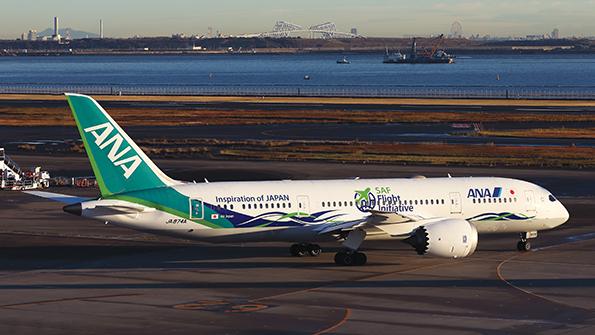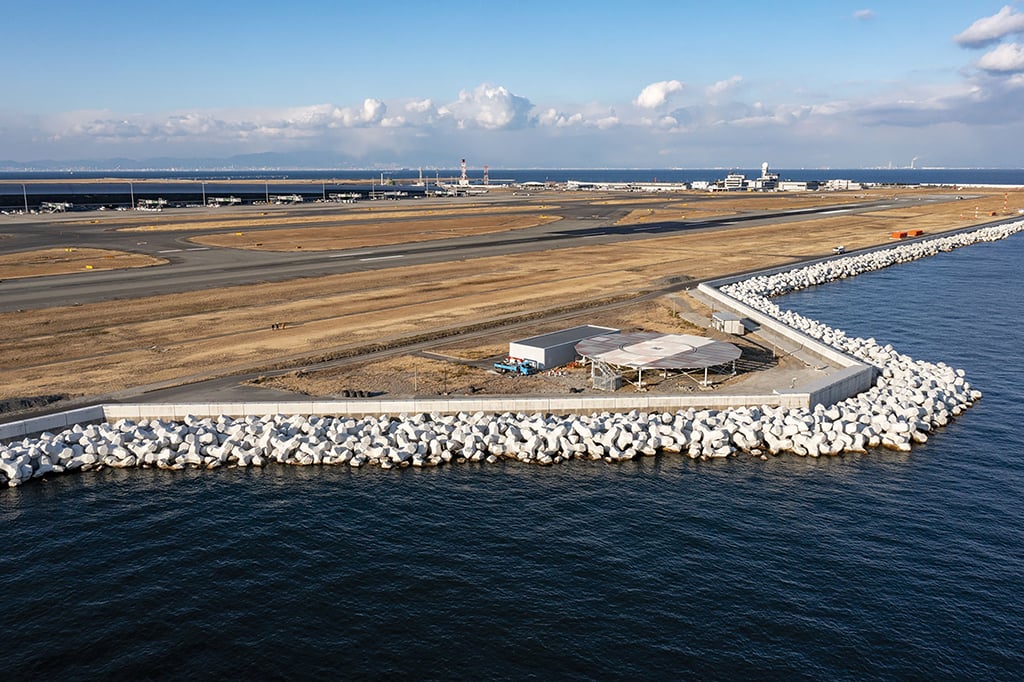This article is published in Aviation Week & Space Technology and is free to read until Aug 30, 2024. If you want to read more articles from this publication, please click the link to subscribe.

This ANA Boeing 787-8 is part of the airline’s Future Promise project, which uses SAF and new cabin materials to reduce weight and the use of plastics.
As airlines and governments step up their efforts to reduce carbon emissions and make sustainable aviation fuels (SAF) more available, Japan is particularly keen to be a regional leader.
Sustainability initiatives are widely supported by the Japanese. The United Nations’ 17 sustainable development goals (SDG) are widely taught and adopted across the country. In 2023, Japan had an SDG score of 79.8%, the highest of all Asian countries and 18th among all 193 UN Member States.
From 2030, Japan will mandate a 10% SAF uptake for airlines and a similar rule is being proposed for fuel suppliers. Also by 2030, Japan’s aviation regulator, the Japan Civil Aviation Bureau (JCAB), aims to produce 1.92 billion liters of SAF, which it believes will more than meet the demand for SAF from all carriers flying in and out of Japan by that year. Getting there, however, will require collaboration.
“How to support the conditions to make this happen is our task through supporting initial activities, but it doesn’t mean it should be from the beginning to the end,” JCAB senior deputy director general Toshiyuki Onuma said.

To that end, JCAB has put together a public-private council consisting of airlines, oil companies, and Japan’s economy, energy, environment, agriculture and transport ministries. The council is supported by JPY336.8 billion ($2.1 billion) in initial investments and feedstocks and is considering a tariff and tax exemption for feedstocks and imported SAF. A JPY30 tax credit for every liter of SAF produced is also under consideration.
However, JCAB acknowledged that only about 15% of the population knows what SAF is, so imposing a SAF-levy on customers might not work in Japan, although Onuma acknowledged it was an “interesting idea.” Another issue, he said, was that there were too many stakeholders in Japan and JCAB has no expertise in managing such funds.
“It is more of an operational issue, but we are not sure how the industry feels. Japanese airlines are generally reluctant to increase prices unless you can explain to customers that the money goes to the government for sustainability,” Onuma said.
Beyond financial help, JCAB is assisting oil producers to develop and certify SAF feedstock beyond traditional waste cooking oil. In April, at the request of an oil producer, JCAB sought ICAO’s approval to add “non-standard” coconuts into the approved list of feedstock.
Non-standard coconuts are those that are either inedible because of cracking or mold or are too small for consumption.
ONBOARDING SUSTAINABILITY
For Japan Airlines (JAL), the notion of “doing the right thing” can be traced back to former CEO Kazuo Inamori, who came onboard in 2010 to steer the airline out of bankruptcy. He instilled a culture of “doing good” and promoting “material and intellectual growth” for all employees—facets that remain true today with regard to sustainability.

A JAL study among its loyalty program members showed that 5% had sustainability in mind; 32% were beginning to act; and 44% were aware of sustainability but not acting on it, suggesting that there were still numerous opportunities to engage customers and reduce aviation’s environmental impact.
JAL director of planning in the airline’s ESG department Kazuya Kameyama said JAL was looking at sustainability across the entire SDG spectrum, which includes diversity of human resources and engaging local destinations to promote sustainable tourism.
In 2022, JAL introduced an option for all passengers to skip inflight meals and expanded its choices for pre-ordered meals in business class to reduce food wastage. The value of meals saved this way are donated to Table For Two, an organization that provides meals for students in developing countries. Data-driven studies also help the right ratio of meal options be assigned to every flight.
Like its rival JAL, All Nippon Airways (ANA), is a founding member of Act For Sky, a group consisting of 27 companies across all sectors, ranging from food producers to trading companies, that aims to increase the production of domestic SAF in Japan.
ANA is the only airline group with an “A” ranking from CDP, an independent global non-profit organization that runs the world’s environmental disclosure system. In May 2023, ANA revised its medium-term environmental target from one that reduced CO2 emissions below fiscal 2019 levels by fiscal 2030 to a target of 10% reduction against FY2019. ANA has also been taking proactive steps in other carbon-reduction initiatives, such as purchasing CO2 removal purchase credits via 1PointFive, which is building a direct air capture plant that should be in operation by 2025. ANA plans to purchase 10,000 metric tonnes of credits per year for three years from 2025.
“The eyes of our stakeholders are on us, and it is our obligation to go forward with these innovations and investments,” ANA chief sustainability officer Chikako Miyata told ATW.
ANA has earmarked two aircraft, a Boeing 787-8 and De Havilland Canada Dash 8, to participate in its ongoing Future Promise project that experiments with new cabin materials that can reduce the use of plastics and weight.
“Our customers have found these interesting. But we have to keep in mind that we have to balance high quality and waste reduction. If we go too far, it will look too shabby,” Miyata said.
In FY2023, ANA reported a 54.2% year-on-year reduction in wastage in meal services. The company is targeting a 70% reduction by 2030.
Another element in Japanese domestic travel options is its famous Shinkansen, or bullet train, that has an extensive network across the country and provides excellent service. The highly popular Toyko-Osaka route takes about two hours either by aircraft or train once air travel security and other factors are taken into account.
But ANA and JAL have no plans to drop or reduce their Osaka-Tokyo services, saying they remain a crucial social infrastructure because train service can be prone to suspension in the event of a natural disaster. JAL added that it might consider looking at intermodal service with Japan Rail in the long term, although nothing is determined. Local politicians will play an important role as well, because they determine the number of bullet train stations that operate in their cities and they typically demand an airport in their districts.
SEVERE WEATHER IMPACT
Operationally, ANA has seen a greater number of flights affected by severe weather. In 2023, there were 17 typhoons, eight fewer than 2022 but the flight cancellation rate has increased from 1% in 2022 to 1.7% in 2023, suggesting that typhoons are becoming stronger and more disruptive.
Osaka-Kansai International Airport (KIX) co-CEO Benoit Rulleau said the most important change he had seen recently has been the revision of business continuity plans from scenario-based, such as typhoons and earthquakes, to one that reacts to the loss of function, such as the loss of electric power, water or runways. JCAB is now using KIX’s standards in some of its policies.
Rulleau, who oversees Osaka-Itami (ITM), KIX and Kobe (UKB) airports, said the number of weather-related disruptions has more than doubled over the last 10 years, while operational-related disruptions have remained steady, even as the number of flights increased.
At KIX, which is sinking into the sea at a rate of 5 cm to 20 cm annually, stronger and earlier storms bring storm surges that threaten more flooding. Rulleau, however, said investments and protections, such as the installation of a seawall and concrete tetrapods to mitigate the effect of rising sea levels and storm surges, are sufficient to counter the problem.
In the snowy island of Hokkaido, Hokkaido Airports Corp. is studying the impact of climate change on its airport operations. The group’s aviation business development general manager, Kenjiro Karahashi, said global warming could affect the amount of snowfall at the Niseko ski resort, which may force visitors to ski further north, increasing demand at those airports.





